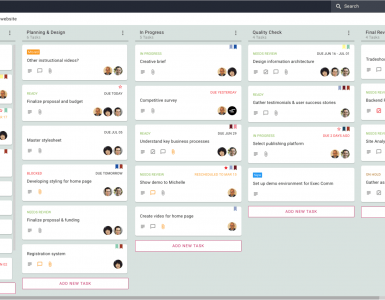
At the time of writing, most of the world is two years into communicating with remote teams.
Most team leaders have tested different team management tactics to form opinions on the benefits/drawbacks of working from home. Statistically, communication and team management are the biggest challenges leaders face.
As a fully remote company helping other teams transition, the oVice team decided to share our ways of handling the most common remote team management challenges.
Ready to dive in?
Without further ado, here are our answers to 7 pressing questions when communicating with remote teams:
1. How do you check if employees are “on the clock”?

Most teams have Slack, messengers, or other collaboration tools downloaded onto their smartphones. This way, they can reply to messages when they are not at their desks. As a result, managers have no way of knowing whether an employee is actually working throughout the day.
Since our team’s key project is a virtual office for remote teams, we use our own tool when communicating with remote teams. At any given moment, we can take a look at the office space and see who is working. When a manager wants to get a quick status update from an engineer, he can walk up to him for a casual team.
Through oVice, we can even seamlessly connect with people in our branch offices in Japan, Korea, and Vietnam. As for the alternatives not involving virtual offices, you can try the following:
- Availability and attendance channels on Slack. Unless teammates post in the #attendance channel that they are unavailable, you as a manager have the right to expect availability.
- Fixed working hours for each member during which you expect them to be available. Since distributed teams are often international, coordinating time zones can be a pain. For this, you can have each team member specify their working hours in a single time zone.
- Task-oriented performance tracking. To run a productive remote team, you don’t need to know if everyone is “clocking” their hours, as long as they get the job done. Shifting the focus from time to task-oriented performance takes some reorganizing – however, it’s easy to do with project management tools like Monday or Asana.
2. How do you get status updates from teammates?

While standup meetings are helpful in bringing the team together, there’s no point in just holding them. If you, as a manager, stopped getting useful information out of daily updates, here are a few ways to improve their yield:
- Start a personal Slack channel for each team member. This is so they can post questions, concerns, project updates, and relevant information. Both the manager and everyone from the team can follow each other’s accounts, and stay in the loop of the latest news and statuses.
- Keep a short rundown of project status updates on Notion. This way, you’ll keep engineers accountable and encourage them to make realistic projections in meetings. Also, scanning through meeting logs gives managers an idea of what the team discussed, concerns, and accomplishments.
- Encourage public update sharing. Rather than exchanging DMs, build a culture of sharing data in public Slack channels. This little tweak helps improve situational awareness when communicating with remote teams. Brainstorming, code reviews, and spontaneous Q&A sessions between teammates become a lot easier.
3. How to onboard new hires seamlessly?

For a new hire, joining a full-remote company can be a nightmare. You don’t know anybody and have no clue where to start. Everything is moving too fast and everyone seems too busy to spend extra time with you.
Managers need to acknowledge the need to mentor and oversee new hires. In our experience, outside of the virtual office, the following was extremely useful:
- Slack onboarding bot walking an employee through all stages of setting up corporate accounts, payroll, and setting 1-on-1s.
- Organization chart that shows who the members of your team are and what they are responsible for. It’s an excellent starting point for new hires, as they know who they should reach out to.
- Slack channel dedicated to welcoming newcomers. Here, everyone joining the team can introduce themselves briefly, and touch on their previous experience, hobbies, interests, and other relevant information.
- Assigned mentors who become a reference point to a new hire. Got a review request? Let your mentor know about it. Found a confusing part in the documentation? Your mentor is here to address your concerns. Also, it’s a good idea to encourage mentors to introduce juniors to other teammates so that new hires are seamlessly integrated into the workplace.
4. How to handle employee training remotely?

Arguably, remote work made organizing company-wide workshops and knowledge-sharing meetings a lot harder. Developers now have to walk the extra mile, and find ways to encourage teammates to grow professionally.
The good news? Remote work doesn’t have to put a stop to employee/recruiter training. Here’s how we go about ensuring project growth when communicating with remote teams:
- Find out what job transitions teammates want to make during 1-on-1 calls. Feeling uninspired at their jobs can cause even FAANG developers to quit their jobs. To make sure your teammates aren’t bored with their daily tasks, allocate some time during catch-up calls to find out whether there are role transitions or new skills an employee wants to learn.
- Encourage experiments. Learning by doing is one of the best ways for remote employees to continue training and professional development. However, it’s not feasible when engineers are swamped with monotonous urgent tasks to be done ASAP. Make sure to give teammates time to test new hypotheses, research the topics they are curious about, reflect on your product development strategy, and so on – be it through side-project Fridays or a few “exploration” hours every day.
- Encourage employees to connect with people outside of their teams. This strategy is beneficial in multiple ways: giving everyone on board a big-picture view of product development, enabling knowledge sharing, and helping teammates foster personal connections.
5. How to avoid micromanagement?

In a distributed workplace, it’s easier to give in to the temptation of breathing down each teammate’s neck with a “Hey, just checking in”. This kind of micromanagement eats at a team leader’s time and no one on the team likes it.
Here’s how oVice managers seamlessly oversee engineers without being push-overs.
- Observe, don’t intrude. Checking out Slack activity from time to time gives insight into the dynamics of the team, people’s concerns, questions, and fires to put out. Most of the time, you can learn more by watching your teammates interact than by pulling each of them out on a 1-on-1.
- Be there to help, not to judge. Keep in mind that a catch-up message can evoke different emotional responses depending on your intent. If a manager is checking in with an employee to praise or give a helpful suggestion, most teammates will be happy to get extra engagement. However, if you are chiming in because you are suspicious or concerned, the engineers on your team will feel micromanaged.
6. How to keep meetings natural?

Smooth interpersonal communication with remote teams is one of the benefits of office-based workplaces. In a remote team, it’s common to lose focus during meetings, multitask, or silently wait until the discussion is over.
To create a smooth communication flow, engineering team leaders can:
- Move away from agendas, goals, and bullet points. Organizing everything you want to say in a meeting helps save a lot of time but it leaves teams with no “breathing room”. If your latest calls with engineers feel robotic and scripted, it may be time to check whether your agenda is not too rigid or your scheduling isn’t too optimistic. Giving all participants 10 extra minutes for chit-chat or voicing their concerns helps bring the team together.
- Don’t rush to wrap the meeting sooner. If you put an hourly meeting on the agenda, it’s okay to take things slower and discuss everything you need to. After all, winning 10 extra minutes by wrapping up sooner only encourages mindless social media scrolling and losing focus before the next engagement. On the other hand, if you keep running out of issues to discuss, and there’s a lot of time left, it’s a good idea to cut the meeting time as a rule.
7. How to synchronize the office team and the remote team?

A hybrid workplace – allowing people to choose whether they come to the office or work from home – is a new trend. On the one hand, it gives employees a chance to escape distractions awaiting them at their places. On the other, meeting in person allows for the building of connections with teammates.
Communicating with remote teams is a unique challenge – it creates a disconnect between the office team and the remote fraction of the team. Often, the distributed half of the team is not in the loop, so can feel left out.
To bridge the gap, hybrid team managers should:
- Encourage the office team to communicate in ways accessible to the remote team: Slack, email, and collaboration platforms.
- Set up game nights and team-building gatherings remotely so that the entire team can join.
- Document (and record) all office-only meetings to keep developers working remotely updated.
Both as a product and a team, oVice was born during the pandemic. Our team is fully remote – some teammates meet in real life, and others have never talked physically. Nevertheless, in two years, we’ve expanded to over 150 employees and keep growing.
The ability to hire people from all over the world and have access to the best tech talent is a huge benefit of remote work – that’s why we want to keep growing as a remote-first company and help other teams do the same.
Managing a remote team is a unique challenge. Its trade-offs and adjustments, borders and time zones separating teams, are all vital components. Technology, creativity, and willingness to collaborate can break down these walls.
Once you take the time to optimize remote workflows and find ways to bring the team together, you’ll find out that remote work is a growth opportunity – not a barrier.
Ready to hire? Our marketplace of over 410,000 diverse freelancers has the skills and expertise needed to skyrocket your business. From marketers to designers, copywriters to SEO experts – browse the talented bunch here!








